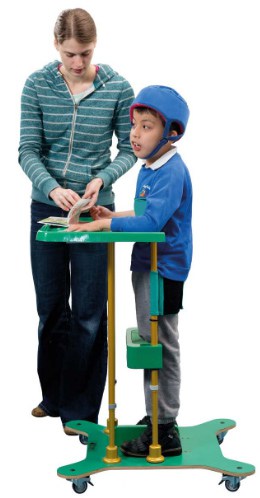Let’s get it clear: 24-hour positioning – where do we stand?

We know the importance of correct positioning whilst seated. People spend a lot of time lying down, so over time, there’s been development of consideration and products for ‘in bed’ positioning under the banner of 24-hour positioning. However, we often see very little thought given to the role that standing should play in these 24 hours, especially for those with mobility challenges.
For those who spend the day sitting or lying, there is much concern about the health of the skin tissues as a result of staying in the same position for a long time. There have been reports over the years of people being moved from a bed with a good skin care mattress into a side chair without any tissue management properties, and where the more concentrated forces of gravity’s pull on the body’s mass through boney prominences of the skeleton are potentially more dangerous.
Apart from tissue integrity issues, the effects of a long-term position in bed or in a seat are important. If the body’s skeleton is misaligned in either circumstance, and the individual cannot change position easily, then there is the risk of the prolonged effects of gravity leading to permanent deformities, contractures, and other elements detrimental to the health of the individual.
The third aspect of 24-hour positioning is the importance of standing. Standing is important for optimizing many physiological functions managed within the torso, such as breathing, blood circulation, and bladder and bowel function. In addition, there are many anatomical benefits derived from standing, such as reduced contractures and spasticity, a better range of motion, normal bone growth and joint development (particularly in children), and pressure relief for most of the body.
The further benefits come from the psycho-social side, where communication, ability to speak, etc are so much easier in the standing position, and the ability to interact eye-to-eye means improved self-confidence and self-esteem. An additional benefit is that those who have the opportunity to stand during the day sleep better at night.
Thus, it is important for those who are mobility-impaired, that an hour a day should be spent in the standing position. For the majority of people, an upright stander to support the individual will cover this need – for more complex challenges where being fully vertical is not appropriate, then prone (face down) or supine (face up) standers are more appropriate.

Further items can be found at www.beshealthcare.net. If you are interested in receiving further information on the topic, please contact barend@beshealthcare.net.
Dr Barend ter Haar has been involved in seating and mobility for over 30 years, including lecturing internationally and developing international seating standards.
Click below to read more from the ‘Let’s get it clear’ series from Dr Barend ter Haar
https://thiis.co.uk/lets-get-it-clear-24-hour-positioning-where-do-we-stand/https://thiis.co.uk/wp-content/uploads/2020/01/24-hour-positioning-Varyflex.jpghttps://thiis.co.uk/wp-content/uploads/2020/01/24-hour-positioning-Varyflex-150x150.jpgAnalysis & InsightsLet's Get It Clear24-hour positioning,BES Healthcare,Dr Barend ter Haar,mattress,Mobility,positioning,Pressure Care,pressure-relief,seating,skin care,standing,tissue viabilityWe know the importance of correct positioning whilst seated. People spend a lot of time lying down, so over time, there’s been development of consideration and products for ‘in bed’ positioning under the banner of 24-hour positioning. However, we often see very little thought given to the role that...Calvin BarnettCalvin Barnettcalvin.barnett@bhta.comAuthorTHIIS Magazine

